Assessing the Performance of GNSS-IR for Sea Level Monitoring During Hurricane-Induced Storm Surges
Abstract
1. Introduction
2. Data and Methods
2.1. Study Area and GNSS Datasets
2.2. Hurricane Datasets
2.3. Methods
3. Results of GNSS-IR-Based Storm Surge Monitoring
3.1. Identification and Monitoring of Storm Surge Events
3.2. Assessment of GNSS-IR Retrieval Accuracy During Storm Surges
4. Discussion
4.1. The Impact of Hurricane Migration
4.2. Evaluation of Temporal Coverage in GNSS-IR Retrievals
4.3. Analysis of Factors Affecting GNSS-IR Monitoring Accuracy
5. Conclusions
- GNSS-IR technology enables the effective monitoring of sea surface height during storm surge events. By integrating data from multiple GNSS systems and frequency bands, the spatiotemporal resolution and overall accuracy of the retrievals can be significantly improved. Specifically, the time coverage rate exceeds 83% with multi-GNSS integration. In calm conditions, the root mean square error (RMSE) of sea level retrievals can reach ~7 cm. During storm surge periods, however, the accuracy degrades markedly to the decimeter level, and can exceed 30 cm under peak surge conditions, especially when the hurricane eye is close. In addition, the site environment (water-reflected condition) is a key factor, which dominates the worse precision of the FLCK site.
- Storm surge processes have a pronounced impact on GNSS-IR retrieval accuracy, particularly when the hurricane eye approaches or passes near the station. The decrease in accuracy closely correlates with the hurricane’s migration path and sea surface reflection/scattering conditions.
- GNSS-IR technology demonstrates high temporal coverage in tide level monitoring. The temporal coverage rate is defined as the percentage of 1 h intervals containing at least one valid sea level retrieval. For a single satellite navigation system, this coverage typically ranges from 40% to 60%. By integrating multiple systems, the overall coverage can be increased to over 85%, as shown in Figure 11, which demonstrates that GNSS-IR has the capability to conduct the continuous monitoring of daily tidal variations and observe extreme events such as storm surges.
- At the FLCK station, the GPS L2 frequency band exhibits a generally poor retrieval accuracy with systematic bias, likely related to the complex non-water reflective environment around the site and the L2 signal’s susceptibility to interference.
Supplementary Materials
Author Contributions
Funding
Data Availability Statement
Acknowledgments
Conflicts of Interest
References
- Muis, S.; Verlaan, M.; Winsemius, H.; Aerts, J.C.J.H.; Ward, P.J. A global reanalysis of storm surges and extreme sea levels. Nat. Commun. 2016, 7, 11969. [Google Scholar] [CrossRef] [PubMed]
- Gabe, T.; Falk, G.; McCarty, M.; Mason, V.W. Hurricane katrina: Social-demographic characteristics of impacted areas. In CRS Report for Congress; CRS: Boca Raton, FL, USA, 2005; Available online: https://sgp.fas.org/crs/misc/RL33141.pdf (accessed on 4 September 2025).
- Eley, E.N.; Subrahmanyam, B.; Trott, C.B. Ocean–Atmosphere Interactions during Hurricanes Marco and Laura. Remote Sens. 2021, 13, 1932. [Google Scholar] [CrossRef]
- Nicholls, R.J.; Lincke, D.; Hinkel, J.; Brown, S.; Vafeidis, A.T.; Meyssignac, B.; Hanson, S.E.; Merkens, J.-L.; Fang, J. A global analysis of subsidence, relative sea-level change and coastal flood exposure. Nat. Clim. Change 2021, 11, 338–342. [Google Scholar] [CrossRef]
- Wang, J.; Gao, W.; Xu, S.; Yu, L. Evaluation of the combined risk of sea level rise, land subsidence, and storm surges on the coastal areas of Shanghai, China. Clim. Change 2012, 115, 537–558. [Google Scholar] [CrossRef]
- Ablain, M.; Cazenave, A.; Larnicol, G.; Balmaseda, M.; Cipollini, P.; Faugère, Y.; Fernandes, M.J.; Henry, O.; Johannessen, J.A.; Knudsen, P.; et al. Improved sea level record over the satellite altimetry era (1993–2010) from the climate change initiative project. Ocean. Sci. 2015, 11, 67–82. [Google Scholar] [CrossRef]
- Lagmay, A.M.F.; Agaton, R.P.; Bahala, M.A.C.; Briones, J.B.L.T.; Cabacaba, K.M.C.; Caro, C.V.C.; Dasallas, L.L.; Gonzalo, L.A.L.; Ladiero, C.N.; Lapidez, J.P.; et al. Devastating storm surges of typhoon haiyan. Int. J. Disaster Risk Reduct. 2015, 11, 1–12. [Google Scholar] [CrossRef]
- Zhang, G.; Kuang, C.; Chen, C. Research on GNSS-R Storm Surge Monitoring Based on Non-Linear Fitting Method. J. Geod. Geodyn. 2025, 45, 500–505, 531. [Google Scholar] [CrossRef]
- Vignudelli, S.; Birol, F.; Benveniste, J.; Fu, L.-L.; Picot, N.; Raynal, M.; Roinard, H. Satellite Altimetry Measurements of Sea Level in the Coastal Zone. Surv. Geophys. 2019, 40, 1319–1349. [Google Scholar] [CrossRef]
- Birol, F.; Fuller, N.; Lyard, F.; Cancet, M.; Niño, F.; Delebecque, C.; Fleury, S.; Toublanc, F.; Melet, A.; Saraceno, M.; et al. Coastal applications from nadir altimetry: Example of the X-TRACK regional products. Adv. Space Res. 2017, 59, 936–953. [Google Scholar] [CrossRef]
- Liu, K.; Wen, Y.; Zeng, J.; Li, Z.; Xu, C. Rapid early afterslip characteristics of the 2010 moment magnitude (Mw) 8.8 Maule earthquake determined with sub-daily GPS solutions. Satell. Navig. 2024, 5, 23. [Google Scholar] [CrossRef]
- Larson, K.M.; Small, E.E.; Gutmann, E.; Bilich, A.; Axelrad, P.; Braun, J. Using GPS multipath to measure soil moisture fluctuations: Initial results. GPS Solut. 2008, 12, 173–177. [Google Scholar] [CrossRef]
- Larson, K.M.; Löfgren, J.S.; Haas, R. Coastal Sea Level Measurements Using a Single Geodetic GPS Receiver. Adv. Space Res. 2013, 51, 1301–1310. [Google Scholar] [CrossRef]
- Löfgren, J.S.; Haas, R.; Scherneck, H.-G. Sea level time series and ocean tide analysis from multipath signals at five GPS sites in different parts of the world. J. Geodyn. 2014, 80, 66–80. [Google Scholar] [CrossRef]
- Chen, L.; Chai, H.; Zheng, N.; Wang, M.; Xiang, M. Feasibility and performance evaluation of low-cost GNSS devices for sea level measurement based on GNSS-IR. Adv. Space Res. 2023, 72, 4651–4662. [Google Scholar] [CrossRef]
- Cahyadi, M.; Bawasir, A.; Susilo; Arief, S. Analysis of Water Level Monitoring using GNSS Interferometric Reflectometry in River Waters. IOP Conf. Ser. Earth Environ. Sci. 2023, 1276, 012020. [Google Scholar] [CrossRef]
- Holden, L.D.; Larson, K.M. Ten years of Lake Taupō surface height estimates using the GNSS interferometric reflectometry. J. Geod. 2021, 95, 74. [Google Scholar] [CrossRef]
- Wang, P.; Tu, R.; Wang, X.; Han, J.; Zhang, J.; Cheng, F.; Lu, X. GNSS-IR water level monitoring for complex environments: Application to Kalabeily Reservoir in Xinjiang, China. Adv. Space Res. 2025, 75, 7035–7048. [Google Scholar] [CrossRef]
- Wang, X.; He, X.; Xiao, R.; Song, M.; Jia, D. Millimeter to centimeter scale precision water-level monitoring using GNSS reflectometry: Application to the south-to-north water diversion project, China. Remote Sens. Environ. 2021, 265, 112645. [Google Scholar] [CrossRef]
- Shan, Q.; Chen, Q.; Liu, Y.; Jiang, W.; Liu, K.; Zhou, X. The potential of GNSS-IR for monitoring daily water level fluctuations up to 15 m. Measurement 2025, 249, 117053. [Google Scholar] [CrossRef]
- Wang, X.; Zhang, Q.; Zhang, S. Sea level estimation from SNR data of geodetic receivers using wavelet analysis. GPS Solut. 2019, 23, 6. [Google Scholar] [CrossRef]
- Zhang, S.; Liu, K.; Liu, Q.; Zhang, C.; Zhang, Q.; Nan, Y. Tide variation monitoring based improved GNSS-MR by empirical mode decomposition. Adv. Space Res. 2019, 63, 3333–3345. [Google Scholar] [CrossRef]
- Peng, D.; Hill, E.M.; Li, L.; Switzer, A.D.; Larson, K.M. Application of GNSS interferometric reflectometry for detecting storm surges. GPS Solut. 2019, 23, 47. [Google Scholar] [CrossRef]
- Vu, P.L.; Ha, M.C.; Frappart, F.; Darrozes, J.; Ramillien, G.; Dufrechou, G.; Gegout, P.; Morichon, D.; Bonneton, P. Identifying 2010 xynthia storm signature in GNSS-R-based tide records. Remote Sens. 2019, 11, 782. [Google Scholar] [CrossRef]
- Wang, X.; He, X.; Shi, J.; Chen, S.; Niu, Z. Estimating sea level, wind direction, significant wave height, and wave peak period using a geodetic GNSS receiver. Remote Sens. Environ. 2022, 279, 113135. [Google Scholar] [CrossRef]
- Zhang, T.; Wang, X. Tide inversion based on GNSS-IR and analysis of barometric correlation under meteorological forcing. GNSS World China 2025, 50, 70–78. [Google Scholar] [CrossRef]
- Larson, K.M.; Lay, T.; Yamazaki, Y.; Cheung, K.F.; Ye, L.; Williams, S.D.P.; Davis, J.L. Dynamic sea level variation from GNSS: 2020 Shumagin earthquake tsunami resonance and Hurricane Laura. Geophys. Res. Lett. 2021, 48, e2020GL091378. [Google Scholar] [CrossRef]
- Chai, H.; Chen, K. Facilitated interferometric reflectometry evaluation and its application in monitoring three typhoon storm surges in hong kong with multi-GNSS constellation. GPS Solut. 2024, 28, 99. [Google Scholar] [CrossRef]
- Li, L.; Qiu, Q.; Ye, M.; Peng, D.; Hsu, Y.-J.; Wang, P.; Shi, H.; Larson, K.M.; Zhang, P. Island-based GNSS-IR network for tsunami detecting and warning. Coast. Eng. 2024, 190, 104501. [Google Scholar] [CrossRef]
- Bilich, A.; Larson, K.M. Mapping the GPS multipath environment using the signal-to-noise ratio (SNR). Radio Sci. 2007, 42, RS6003. [Google Scholar] [CrossRef]
- Feng, P.; Haas, R.; Elgered, G. A novel tropospheric error formula for ground-based GNSS interferometric reflectometry. IEEE Trans. Geosci. Remote Sens. 2023, 61, 5802918. [Google Scholar] [CrossRef]
- Wang, X.; Song, M.; He, X. Simulation and Correction of Double-Peak Errors in GPS L2P(Y) Signals for GNSS-IR Applications. IEEE Geosci. Remote Sens. Lett. 2025, 22, 3001205. [Google Scholar] [CrossRef]

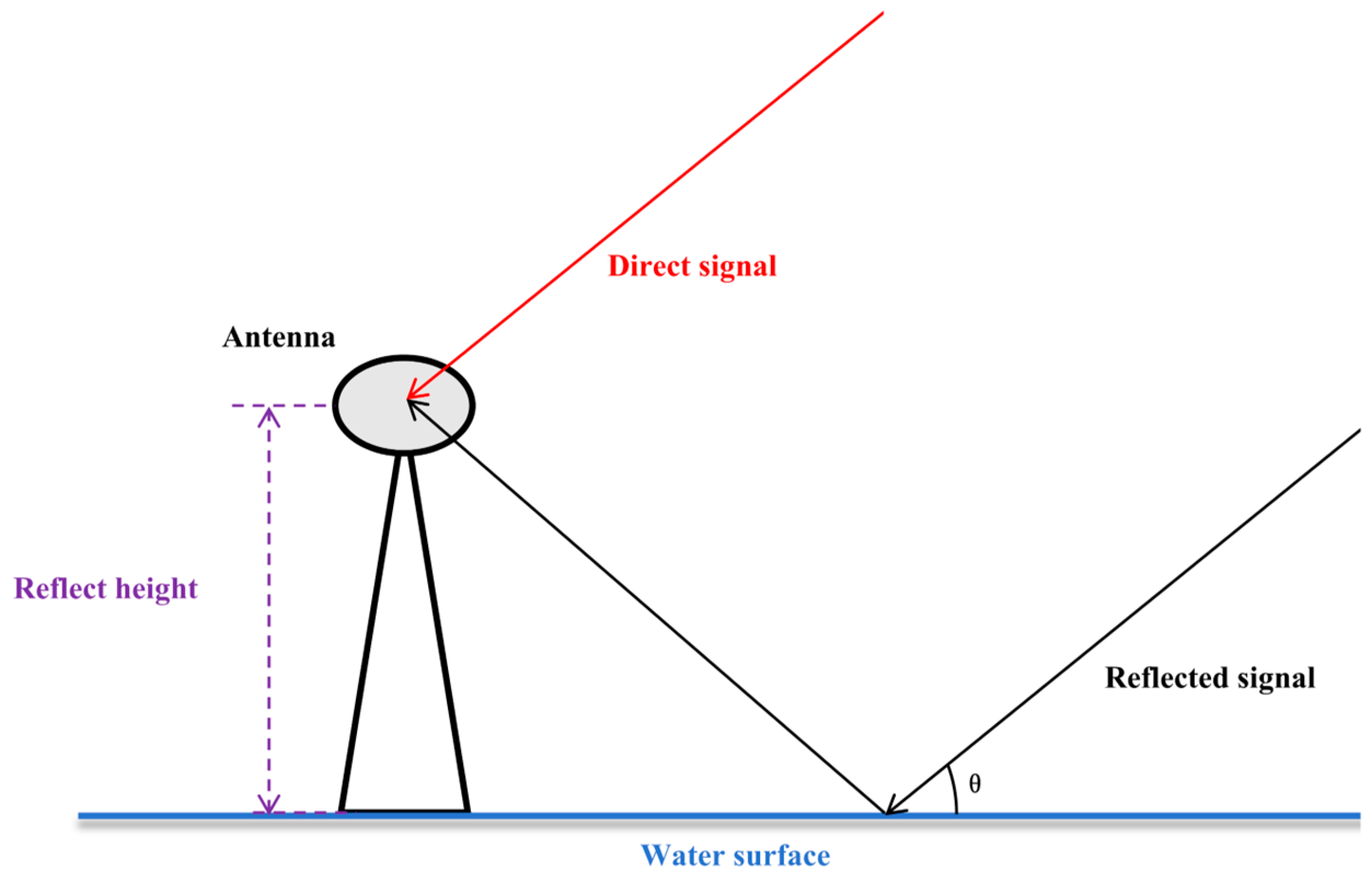
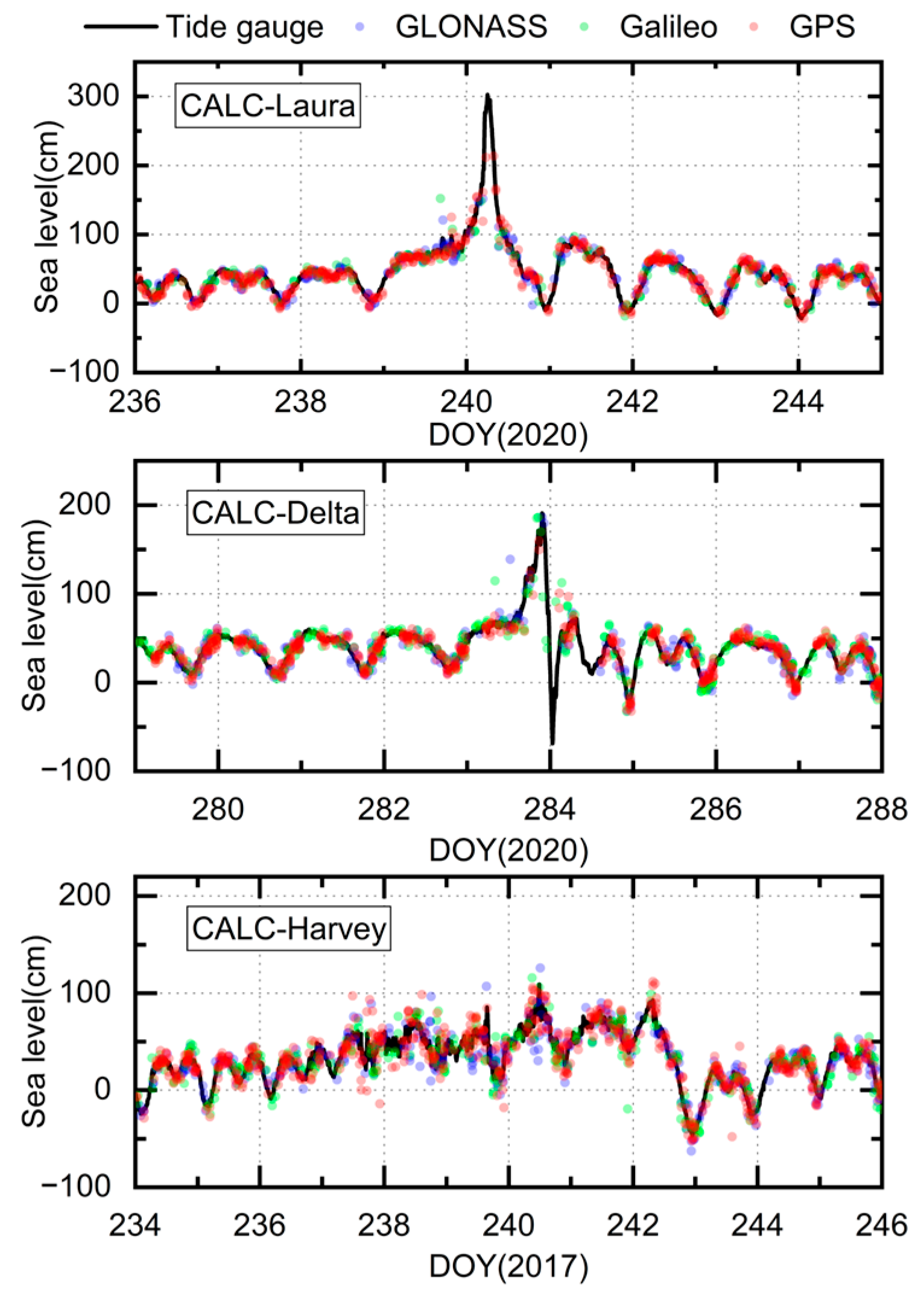
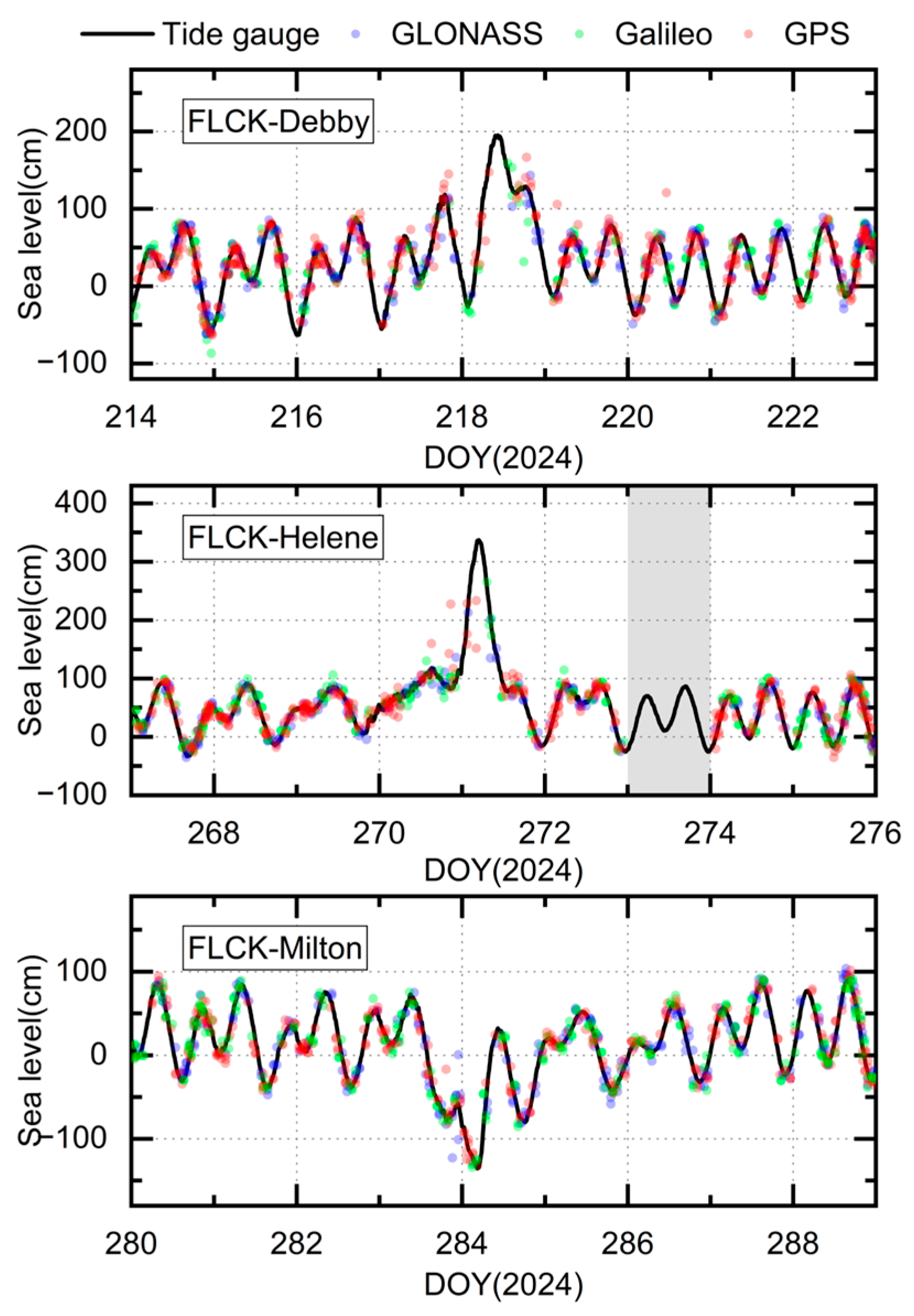
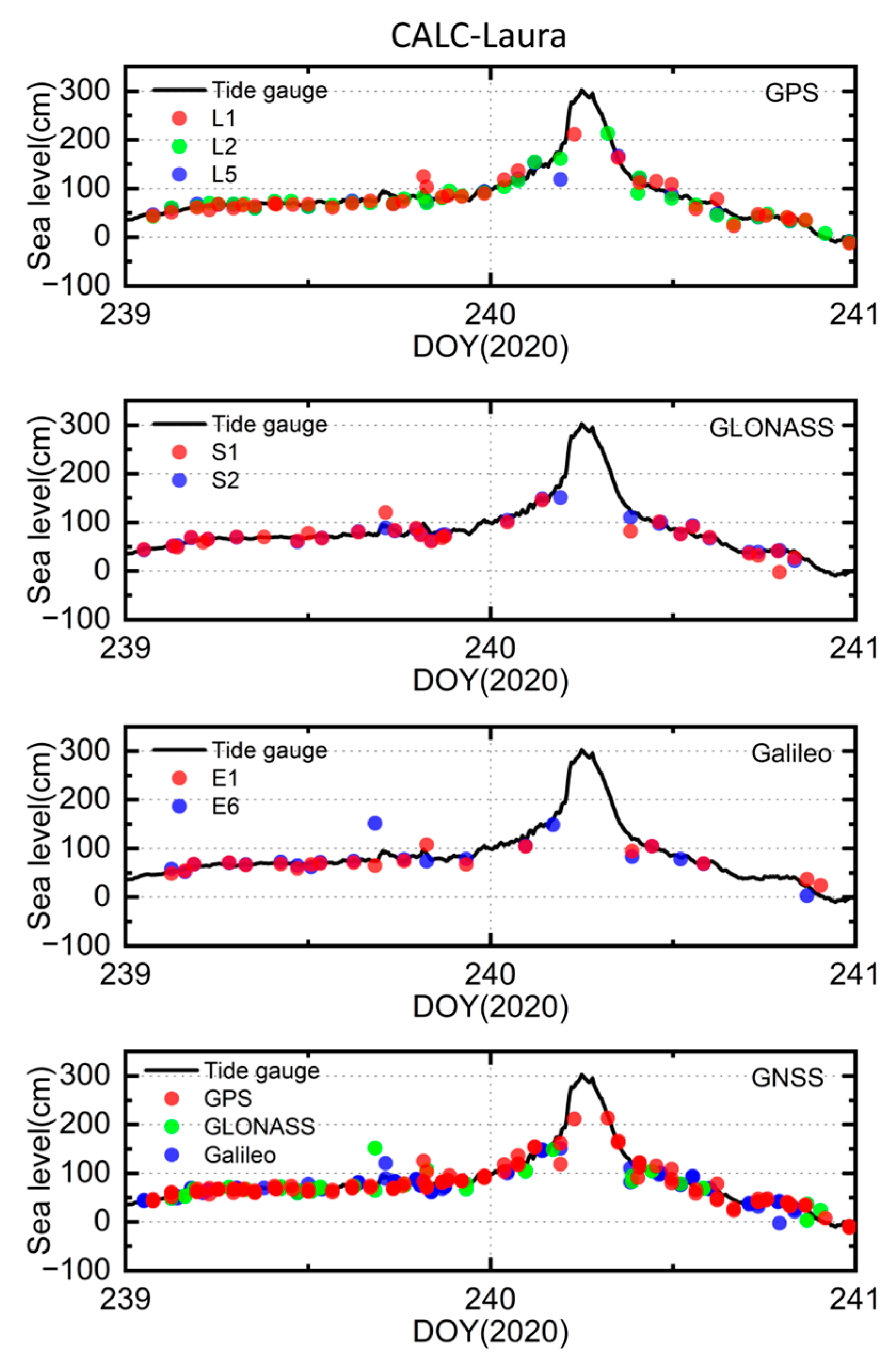
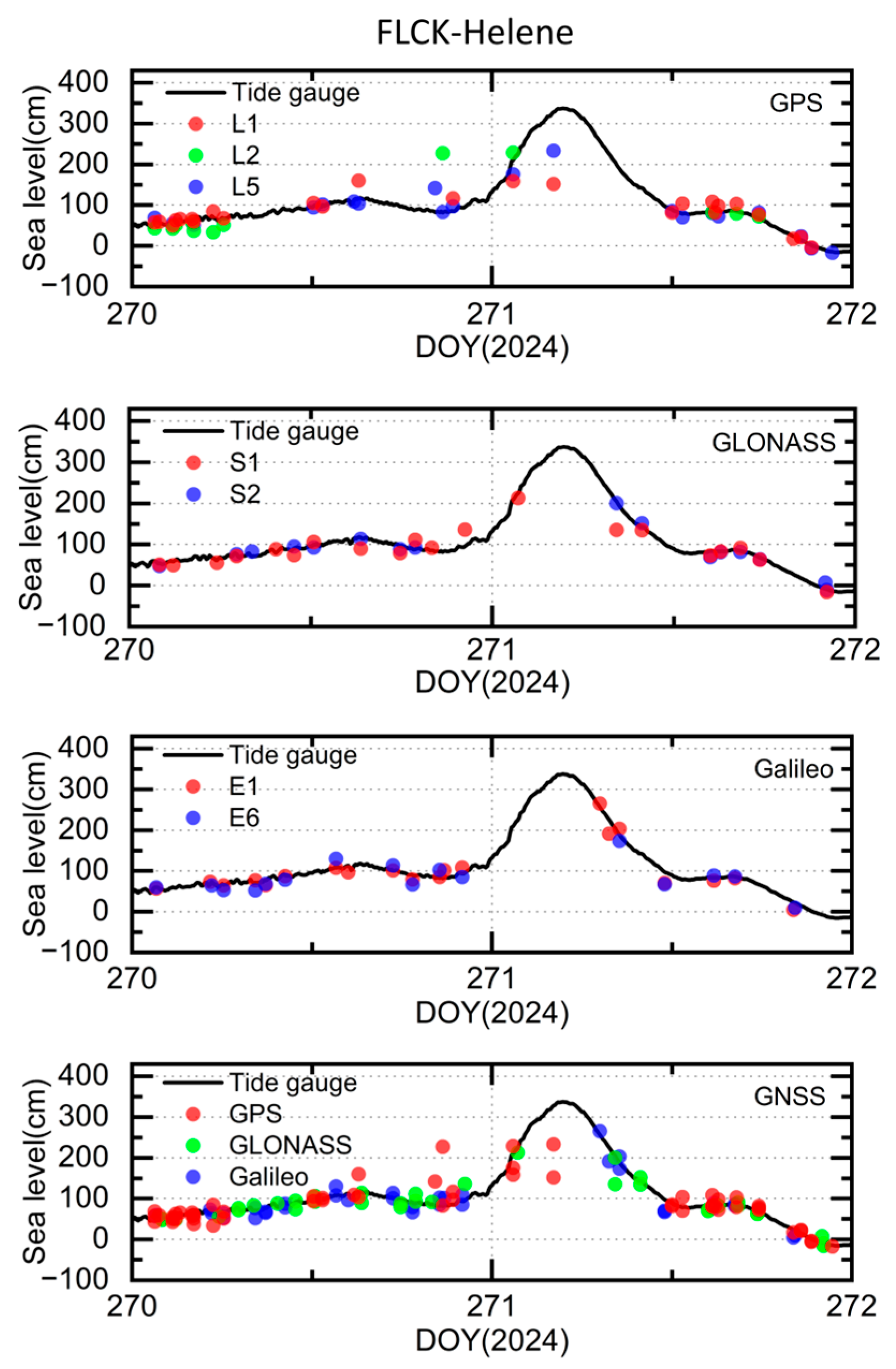



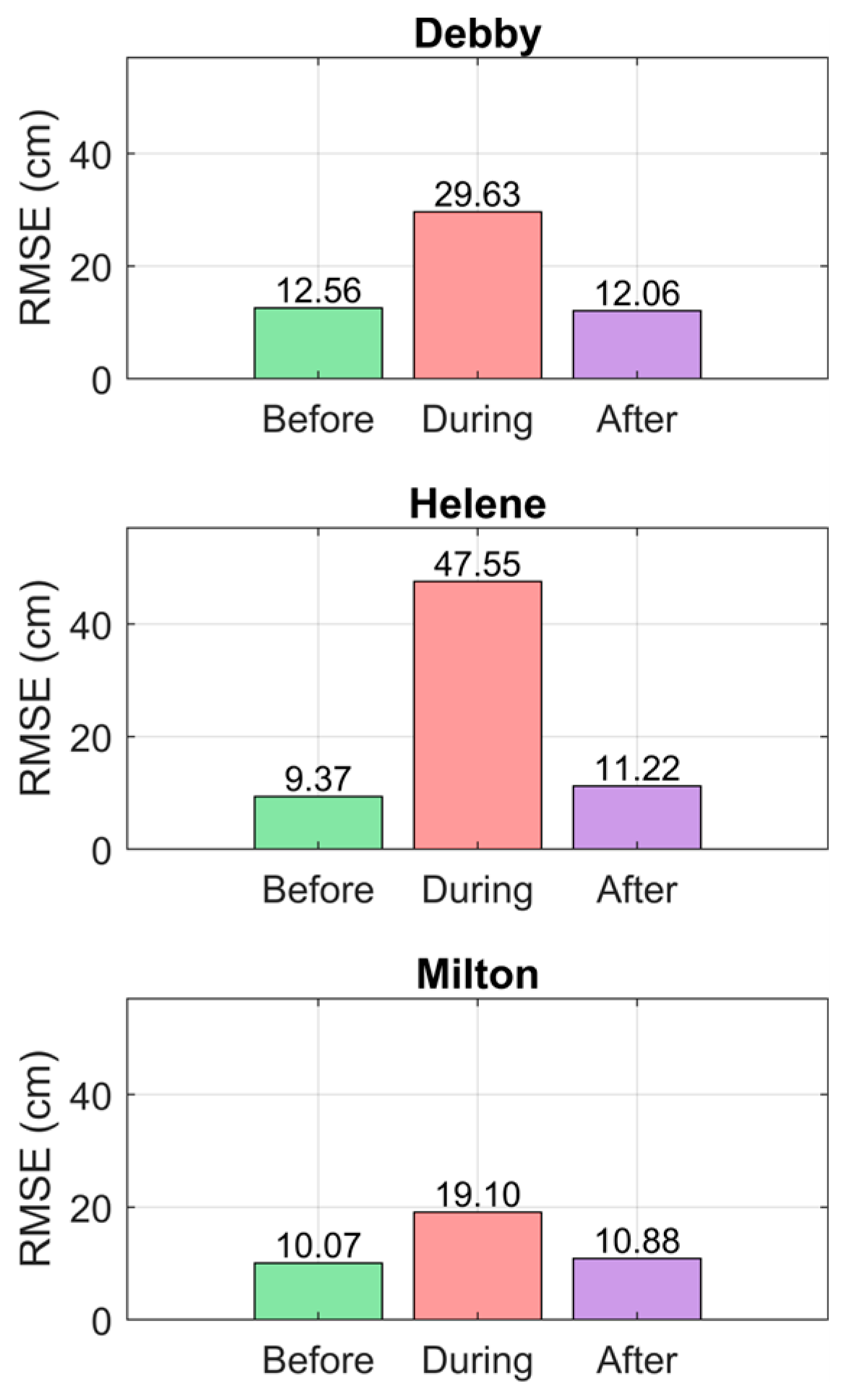
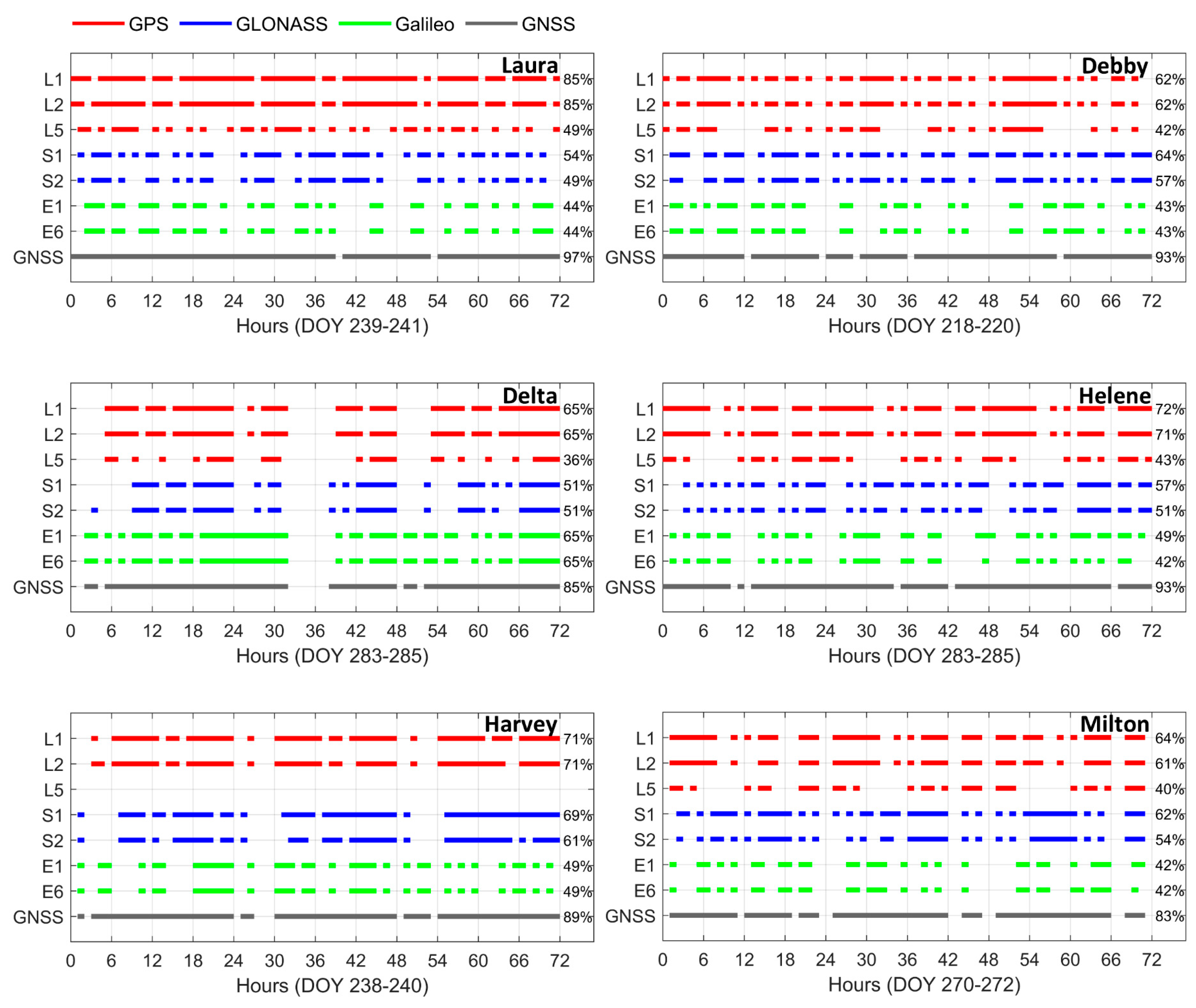
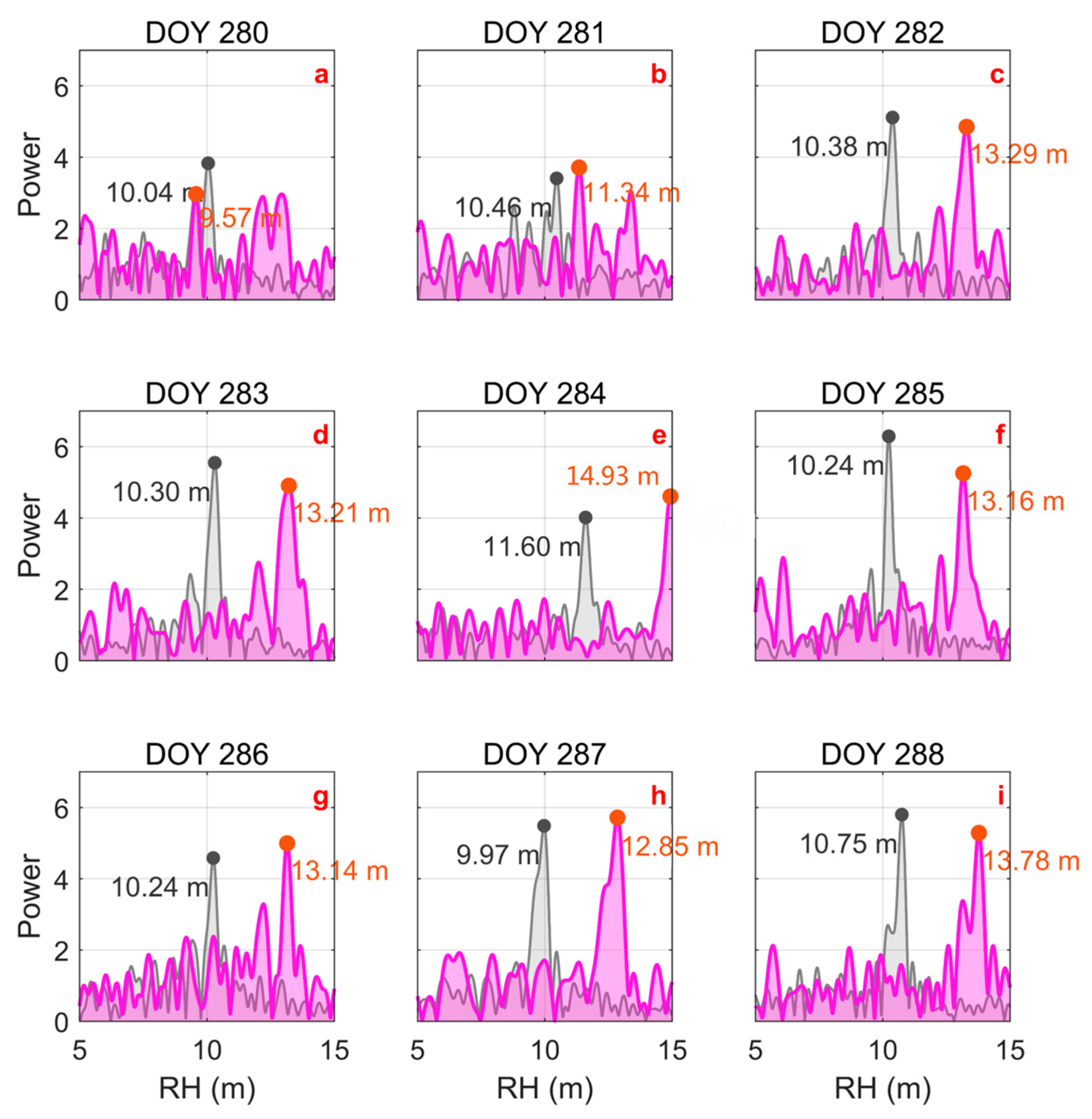
| Hurricane | Time | Maximum Wind Speed | The Closest Distance to the Station |
|---|---|---|---|
| Laura | August 2020 | 240 km/h | <10 km (CALC) |
| Delta | October 2020 | 222 km/h | ≈30 km (CALC) |
| Harvey | August 2017 | 213 km/h | <20 km (CALC) |
| Debby | August 2024 | 130 km/h | ≈80 km (FLCK) |
| Helene | September 2024 | 222 km/h | ≈110 km (FLCK) |
| Milton | October 2024 | 286 km/h | ≈200 km (FLCK) |
| System | Band | Hurricane Laura | Hurricane Helene | ||
|---|---|---|---|---|---|
| RMSE (cm) | Num | RMSE (cm) | Num | ||
| GPS | L1 | 14.90 | 40 | 39.52 | 25 |
| L2 | 10.39 | 41 | 51.59 | 13 | |
| L5 | 15.18 | 22 | 27.23 | 20 | |
| GLONASS | S1 | 14.86 | 31 | 21.42 | 20 |
| S2 | 8.24 | 30 | 7.70 | 16 | |
| Galileo | E1 | 11.03 | 20 | 15.53 | 16 |
| E6 | 19.83 | 21 | 13.77 | 20 | |
| GNSS | --- | 13.61 | 205 | 28.59 | 130 |
| System | Band | Laura | Delta | Harvey | Debby | Helene | Milton |
|---|---|---|---|---|---|---|---|
| GPS | L1 | 7.58 | 8.35 | 13.40 | 14.65 | 17.94 | 10.20 |
| L2 | 7.20 | 7.47 | 11.98 | 40.60 | 24.55 | 95.26 | |
| L5 | 7.52 | 5.48 | --- | 11.56 | 15.70 | 11.71 | |
| GLONASS | S1 | 7.74 | 11.16 | 13.83 | 12.30 | 12.02 | 10.98 |
| S2 | 6.06 | 7.53 | 9.71 | 13.59 | 9.71 | 13.27 | |
| Galileo | E1 | 9.43 | 13.07 | 12.16 | 13.21 | 13.00 | 11.48 |
| E6 | 9.60 | 14.01 | 11.64 | 16.43 | 13.08 | 12.78 | |
| GNSS | --- | 7.92 | 10.05 | 12.25 | 18.71 | 15.67 | 31.61 |
Disclaimer/Publisher’s Note: The statements, opinions and data contained in all publications are solely those of the individual author(s) and contributor(s) and not of MDPI and/or the editor(s). MDPI and/or the editor(s) disclaim responsibility for any injury to people or property resulting from any ideas, methods, instructions or products referred to in the content. |
© 2025 by the authors. Licensee MDPI, Basel, Switzerland. This article is an open access article distributed under the terms and conditions of the Creative Commons Attribution (CC BY) license (https://creativecommons.org/licenses/by/4.0/).
Share and Cite
Zhang, R.; Liu, K.; Wang, X.; Li, Z.; Xie, T.; Chen, Q.; Chang, X. Assessing the Performance of GNSS-IR for Sea Level Monitoring During Hurricane-Induced Storm Surges. Remote Sens. 2025, 17, 3132. https://doi.org/10.3390/rs17183132
Zhang R, Liu K, Wang X, Li Z, Xie T, Chen Q, Chang X. Assessing the Performance of GNSS-IR for Sea Level Monitoring During Hurricane-Induced Storm Surges. Remote Sensing. 2025; 17(18):3132. https://doi.org/10.3390/rs17183132
Chicago/Turabian StyleZhang, Runtao, Kai Liu, Xue Wang, Zhao Li, Tao Xie, Qusen Chen, and Xin Chang. 2025. "Assessing the Performance of GNSS-IR for Sea Level Monitoring During Hurricane-Induced Storm Surges" Remote Sensing 17, no. 18: 3132. https://doi.org/10.3390/rs17183132
APA StyleZhang, R., Liu, K., Wang, X., Li, Z., Xie, T., Chen, Q., & Chang, X. (2025). Assessing the Performance of GNSS-IR for Sea Level Monitoring During Hurricane-Induced Storm Surges. Remote Sensing, 17(18), 3132. https://doi.org/10.3390/rs17183132







